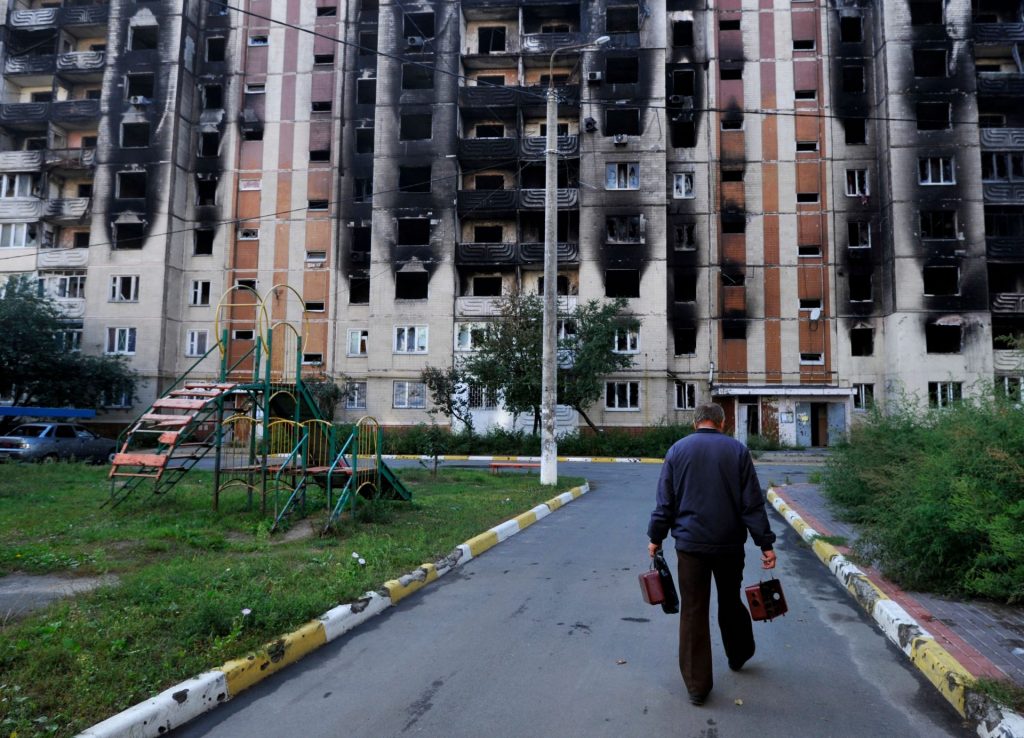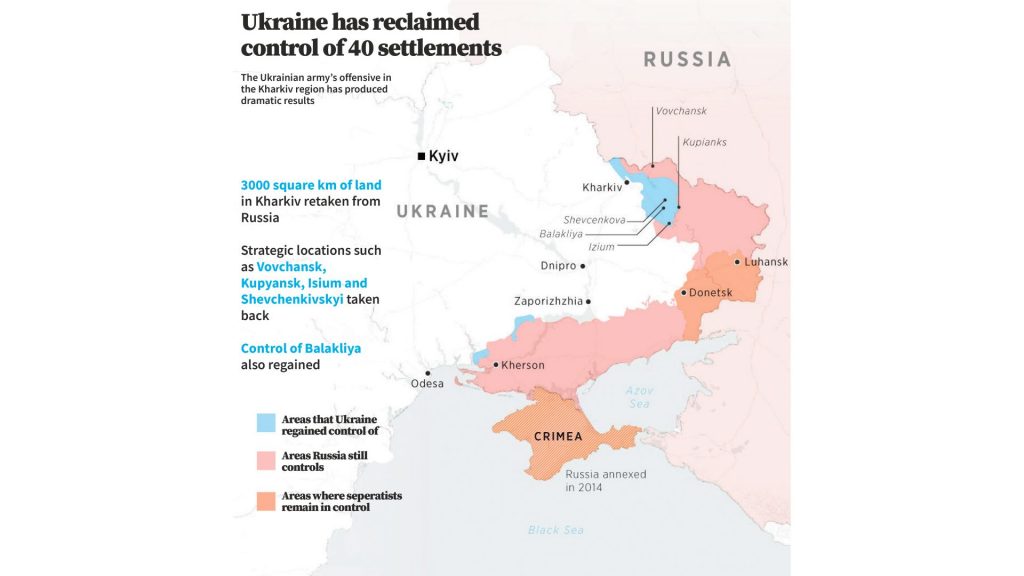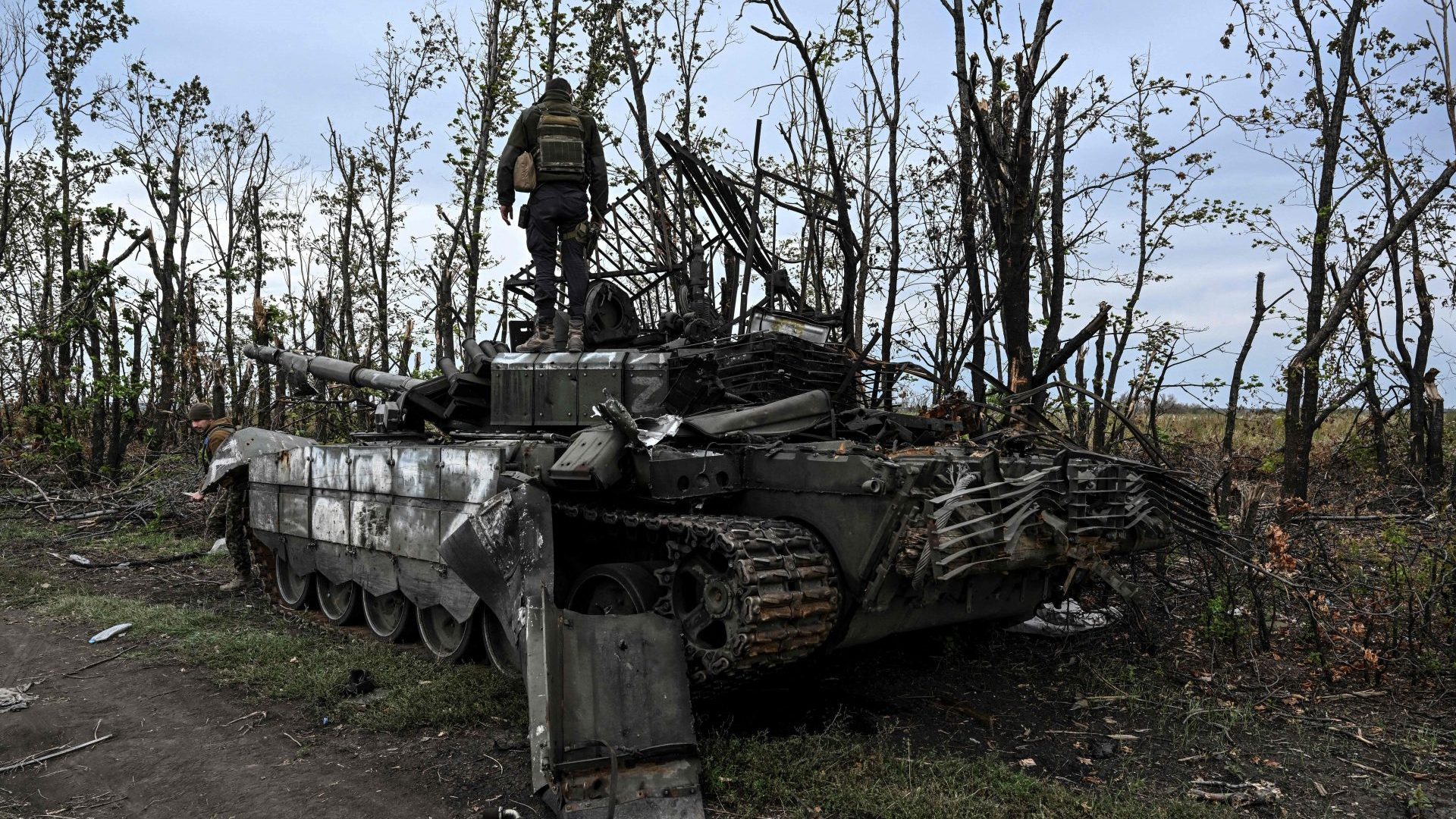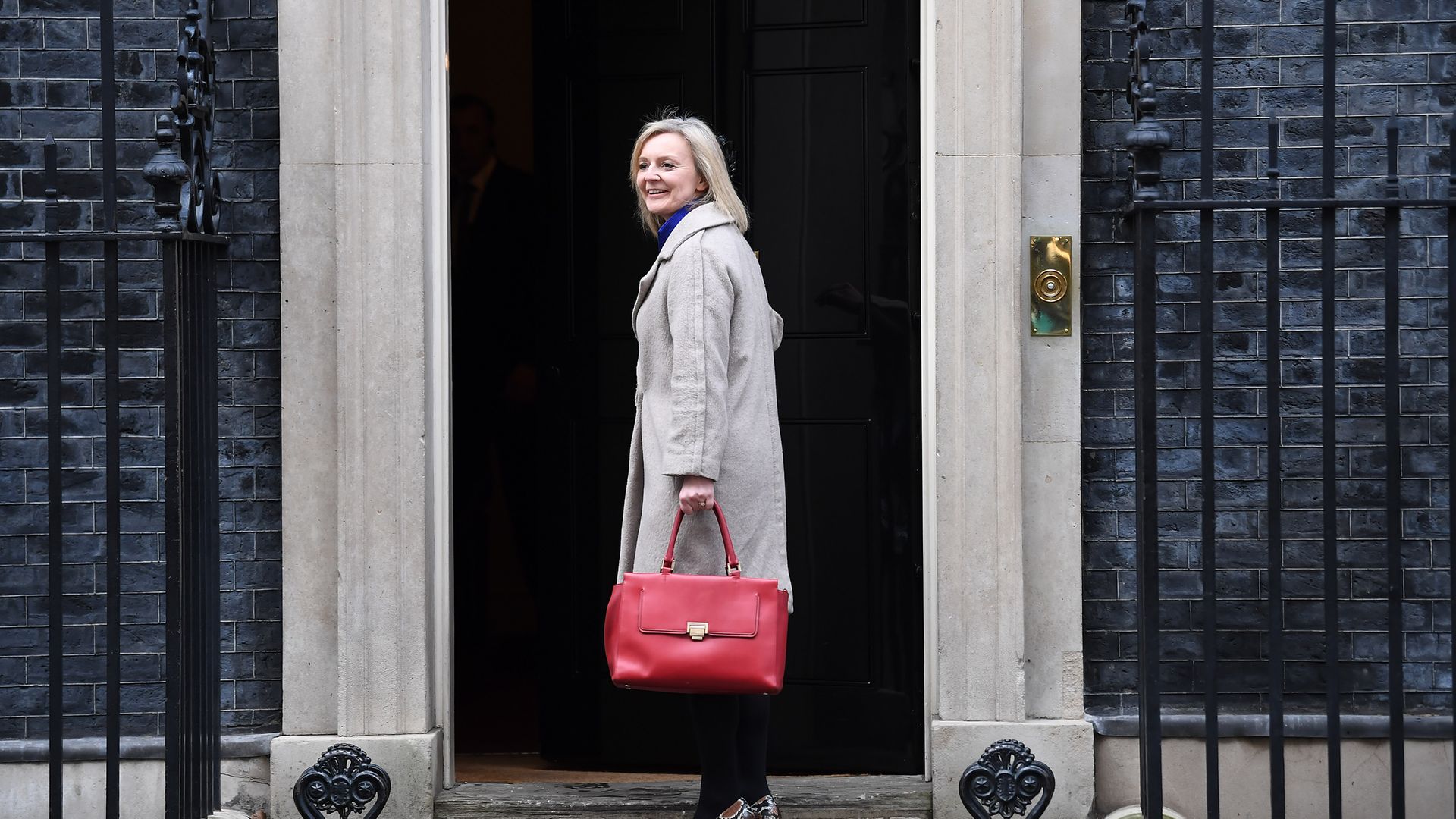Sometimes, military forces just crack. And when they do, everything goes at once.
Since Russia’s invasion of Ukraine began in February, we’ve seen Vladimir Putin’s forces getting stretched across the 1,500-mile fighting front. Their lack of adequate manpower has been exposed; so too have been their logistical problems and an inability to do much about Ukraine’s new deep attacks on their headquarters, ammunition stocks, and choke points. And all the while we knew that Ukrainian forces, with much Nato equipment and support, were preparing western-style battle plans.
We understood the much-advertised Ukrainian counter-offensive would not just be a clash of arms but a battle between Russian and Nato ways of war-fighting. There was some trepidation in western capitals about how it would play out. But it seems that even Kyiv has been surprised and delighted at just how completely Russian forces have cracked along the leading edge of their grinding, fivemonth offensive around Kharkiv and the Donbas region.
Early in the war, Russian forces lost the initiative and were forced to withdraw from Kyiv, Kharkiv, Chernihiv and Sumy. Then they made slow and painful advances across the Donbas and the south of the country, occupying 20% of Ukrainian territory. Their advances were restricted in some places and locally reversed in others. In effect, Russian forces had been brought to a standstill by the Ukrainians who learned quickly and re-equipped themselves as best they could.
But now, in last week’s dramatic dual offensive – at Kherson in the south-west and in Kharkiv and the Donbas in the east – significant Russian forces have simply been defeated on the battlefield; out-thought and out-fought in set-piece engagements. That hasn’t happened to the Russians since December 1942, and the sheer humiliation of it is bouncing around even Kremlin-controlled TV channels.
It’s doubtful that Kyiv deliberately set up the counter-offensive in Kherson as a conscious ploy to pull Russian troops away from Kharkiv. But that is what happened – more evidence, perhaps, that Mr Putin, without any military experience, really is now making the operational decisions. But the Ukrainians must have seen this blunder as an opportunity and were able to assemble – without being detected by Russian intelligence – a full division to the west of Russian forces for a surprise offensive.
Of course, having declared months ago the objective of re-taking Kherson, Ukraine must still do so, or the overall counter-offensive will be deemed a failure. And Kherson, sitting on the banks of the Dnieper, controlling much of the access to Crimea, is more strategically significant than the present frontline in the Donbas.
But Ukrainian success in Kharkiv and the Donbas is spectacular. It may advance by months the point that many of us were anticipating would happen next year, when the military pendulum swings back towards Ukraine and Russian forces struggle to hold the ground they have occupied since February, perhaps even some of the territory they occupied in 2014.
In the Kharkiv oblast, Ukrainian forces took Balakliya on September 6 and then thrust north-east and southeast, simultaneously attacking from further south against Lyman and Izium. By September 12 all Russian forces – about 10,000 troops – west of the River Oskil had abandoned most of their equipment and withdrawn, or else been forced to surrender. The Ukrainians retook over 1,000 sq km in the pocket they created against the Oskil River.
The Kremlin declared that it was “repositioning its troops” ’from Kharkiv – leaving, in fact – to defend the areas of Luhansk and Donetsk, further south, since Ukrainian forces were now in a position to try to retake Lysychansk, Severodonetsk in Luhansk, and perhaps Donetsk itself, having already attacked the airport.
At the very least, Russian withdrawal from the southern end of the pocket takes the pressure off Slavyansk and Kramatorsk – the two major Donbas cities still in Ukrainian hands. And Putin doesn’t achieve even his reduced objective of occupying the Donbas until both are under Russian control. After last week, Mr Putin may be wondering just how much of the Donbas he will still have when the Ukrainian offensive eventually runs out of steam. It may have a little way to go yet.
The Ukrainians appear to have created three fighting divisions. One is committed to the Kherson front, one has been used in Kharkiv, and on the normal military principle of “two up, one back”, one is held in reserve. One or two more divisions appear to be in the process of forming behind that again. So the Ukrainian high command may be waiting to see if it needs to commit its third division in reinforcement operations. If not, it might choose the moment to push directly south to Melitopol or Mariupol and split Russia’s “land bridge” between the Donbas and Crimea.
What happened to the Russians against the Oskil river is a smaller version of the position Ukrainian forces are trying to engineer against the Russians in Kherson in the south-west – trapping some 20,000 of Russia’s 49th and 35th Combined Arms Armies west of the Dnieper river – making their position difficult to reinforce and effectively untenable.
So far, this wider offensive has begun to turn Russian forces south-west of Kherson city at Tomnya Balka near the coast; to get within 18 miles of Kherson’s western outskirts, and has broken through at two points further north to threaten Russian forces defending Nova Kakhovka.
If the Ukrainians pull off an effective encirclement of these more experienced Russian troops west of the Dnieper, in parallel with their growing success in the Donbas, the strategic pendulum really will be swinging back towards Ukraine this side of the winter.
How to account for this pendulum swing? Of course, the quality of Russian troops around Balakliya, where the Kharkiv breakthrough began, was extremely poor. Rosgvardia – interior ministry troops designed only to fight civilians – alongside semi-amateur forces from the breakaway republics, disintegrated immediately. The crude difference in the human willingness to fight, as between those invading a country and those fighting for its very life, is always a critical factor.
But the fact that the Russian collapse became cumulative also speaks volumes for Moscow’s lack of command flexibility, the difficulty of switching logistics quickly enough, and yet another catastrophic intelligence failure.
Even more worrying for the Kremlin, Russian commanders still have no answers to Ukraine’s western-supplied, long-range artillery and precision rockets. They have created havoc in the rear areas and hampered Russia’s response to every Ukrainian move.

Russian air power has been performing sub-optimally from the start of the war – vulnerable to ground-base defence systems and reluctant to spend much time over hostile territory. But now, Russia’s air force has completely failed to give its troops protection when they most needed it.
Not least, the speed of collapse has put a great deal of intact military equipment into Ukrainian hands, alongside, we assume, valuable operational software as field headquarters were overrun.
On the Ukrainian side of the equation, it is evident that Kyiv’s commanders have been able to plan for genuinely combined operations – using air and ground forces together and integrating the different elements of ground forces between infantry, armour and artillery. The small cadre of Ukraine’s army and air force that began this war has evidently expanded flexibly enough to embody the combined arms ethic.
That success is not only down to human courage and military morale, but owes a great deal to the last eight years re-learning a western style of command, control and intelligence. After the debacle of 2014, Ukrainian forces took western advice and concentrated on getting the basics right, creating small forces that could maintain a level of quality as they expanded. Now, as they balloon towards the 700,000 Kyiv says it wants to put into the field next year, commanders know that Ukrainian forces have a modernised backbone.
They will have to be wary of over-extending their forces if this dual offensive keeps moving quickly, and “sustainment”, as ever, will determine which side prevails. But this offensive has proved to Ukrainian commanders that they have the sort of forces capable of winning open battles against the Russians.
The Kremlin, conversely, has made successive attempts since the mid-1990s to reform its ground forces. Though it keeps changing structures, it has never succeeded in truly modernising them, still less the thinking of key commanders. Russia needs to strip its forces back to find out what is still going wrong, and take the time to put it right. But that’s a deep systemic problem that won’t help Putin win this particular war.

For the coming weeks, Ukraine will try to keep Russian forces off-balance and liberate whatever territories they can before the weather changes. It’s important to demonstrate to the west that as long as its support continues, Ukraine really is capable of throwing Russian forces out. Meanwhile, Russia will have to decide which of the two fronts is more important to it, reinforce one of them, and dig in until winter when life gets hard for the attackers.
A shaky ceasefire beckons some time next year. But it may now be on terms more favourable to Ukraine than even the government in Kyiv imagined a week ago.
Michael Clarke is Distinguished Fellow at the Royal United Services Institute.



